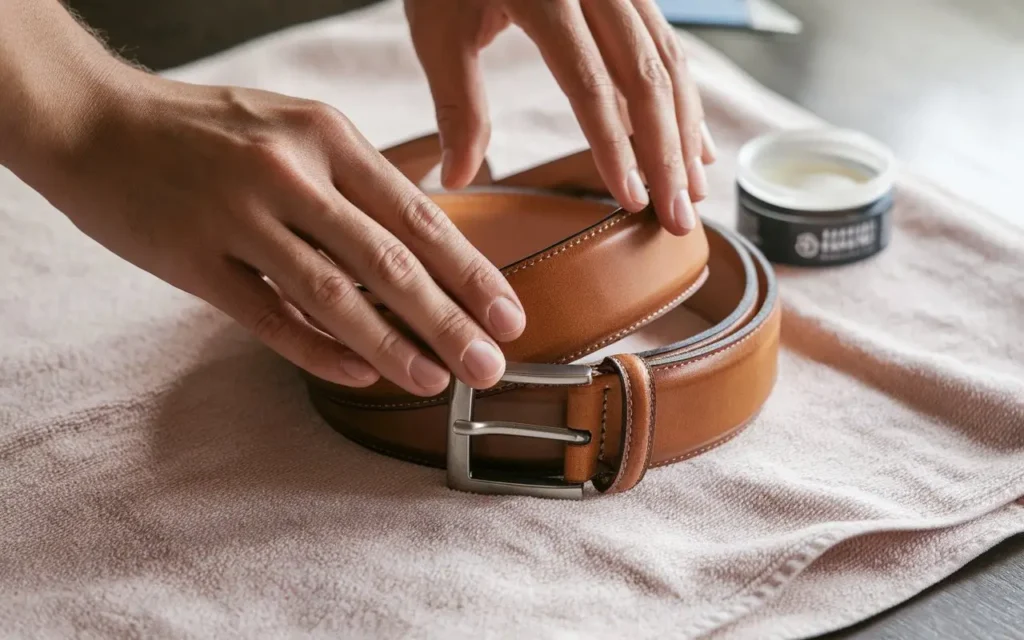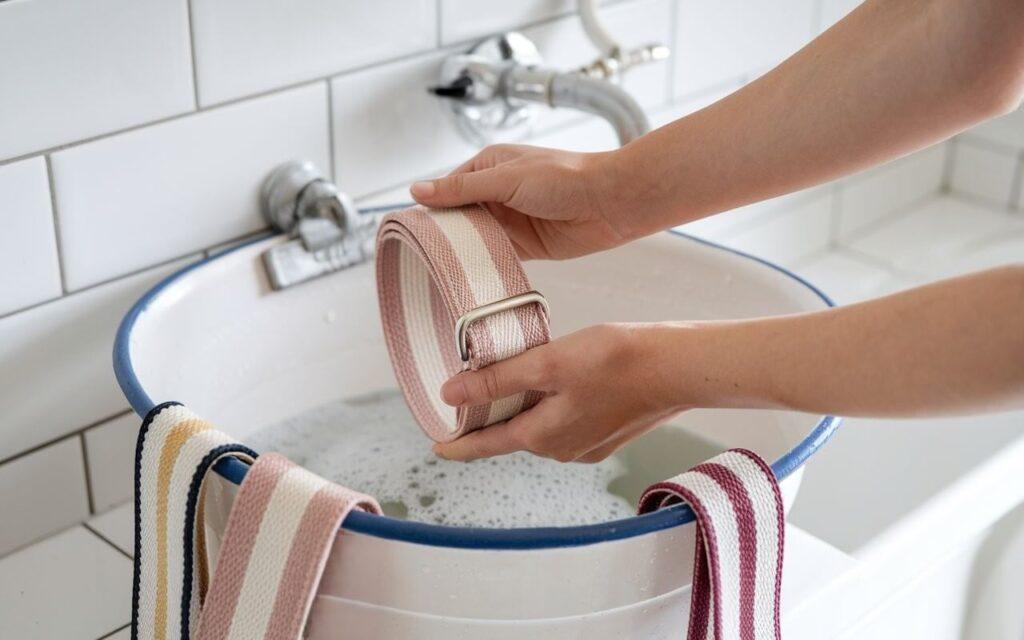Belt Maintenance 101: Caring for Every Material
Belts are an essential part of any man’s wardrobe, but they don’t always get the care they deserve. Like any accessory, belts can wear out over time, especially if they’re not properly maintained. Whether your belt is made of leather, fabric, or synthetic materials, each requires a bit of attention to keep it looking sharp and functioning well.
In this guide, we’ll cover simple, practical ways to maintain belts made from different materials, so they stay looking good and doing their job for the long haul.
Contents
Why Belt Care Matters
Think about it – your belt goes through a lot. It’s bent, twisted, and exposed to sweat, rain, and who knows what else. Taking care of your belt isn’t just about looks; it’s about making a quality accessory last. Plus, a well-maintained belt can elevate your whole outfit. Trust me, people notice these things! With that in mind, let’s start our Belt Care 101 guide with the most commonly used material, leather.
1. Leather Belts
Leather belts are like the Swiss Army knives of the accessory world – versatile, durable, and always in style. But they need some TLC to keep looking their best.
Cleaning Leather Belts
- Start with a soft, dry cloth to remove dust and surface dirt.
- For tougher stains, use a damp cloth with a tiny bit of mild soap.
- Never soak your leather belt – water is not its friend!
Pro tip: Test any cleaning method on a small, hidden area first.
Conditioning Is Key
Leather needs moisture to stay supple and prevent cracking. Every few months, give your belt some love with a good leather conditioner.

My go-to is the Bickmore Bick 4 Leather Conditioner. It’s easy to use and keeps leather soft without leaving a greasy residue.
Storing Leather Belts
- Hang your belt or roll it loosely – no tight coils!
- Keep it in a cool, dry place away from direct sunlight.
- Use a belt hanger to prevent creases. The Amazon Basics Wooden Belt Hanger is a game-changer for organizing and preserving your belts.
Dealing with Scratches and Scuffs
Minor scratches? No worries. Gently buff them out with a soft cloth. For deeper scratches, a matching color shoe polish can work wonders. Apply sparingly, buff, and voila – good as new!
2. Suede Belts
Suede belts add a touch of luxe to any outfit, but they can be high-maintenance if you’re not careful.
Brushing and Cleaning Suede
- Use a suede brush (like the Shacke Suede & Nubuck 4-Way Brush) regularly to remove dirt and restore naps.
- For stubborn stains, try a suede eraser.
- Always brush in one direction to maintain the suede’s texture.
Protecting Suede From Water Damage
Water and suede are mortal enemies. Protect your belt with a good suede protector spray. The Scotchgard Suede & Nubuck Protector is my top pick – it repels water without changing the suede’s color or texture.
Removing Stains From Suede
- Act fast! Blot (don’t rub) fresh stains immediately.
- For oil stains, sprinkle cornstarch or talcum powder, let it sit overnight, then brush off.
- Tougher stains? A suede cleaner like Saphir Suede Cleaner can work miracles.
3. Fabric Belts
Canvas, cotton, and nylon belts are perfect for laid-back looks. They’re easy to care for, but there are still some tricks to keep them looking fresh.
To machine wash or not to machine wash?
- Most fabric belts can handle a gentle machine wash.
- Use cold water and a mild detergent.
- Place the belt in a mesh laundry bag to prevent tangling.
For delicate or embellished belts, stick to hand washing:

- Fill a basin with cool water and a touch of mild detergent.
- Gently agitate the belt in the water.
- Rinse thoroughly with clean water.
Drying Techniques
- Air drying is the way to go. Lay the belt flat or hang it to dry.
- Avoid direct sunlight or heat sources – they can cause shrinkage or fading.
Ironing and Reshaping
If your fabric belt looks a bit rumpled:
- Set your iron to the appropriate heat for the fabric.
- Place a thin cloth over the belt to protect it.
- Iron gently, moving in the direction of the fabric’s weave.
For belts that have stretched out, a quick iron can help them regain their shape.
4. Synthetic Leather Belts
Synthetic leather (or “faux leather”) belts are affordable and often vegan-friendly. They need a different approach than real leather.
Cleaning Methods
- Wipe with a damp cloth for everyday cleaning.
- For tougher stains, use a mild soap solution.
- Avoid harsh chemicals – they can damage the synthetic coating.
Avoiding Cracks and Peeling
Synthetic leather is prone to peeling if not cared for properly. To prevent this:
- Avoid extreme temperatures.
- Don’t fold or crease the belt when storing.
- Apply a vinyl conditioner occasionally to keep the material supple.
5. Elastic Belts
Elastic belts are all about comfort and flexibility. Here’s how to keep them snappy:
Washing and Drying
- Hand wash in cool water with mild detergent.
- Gently squeeze out excess water – don’t wring!
- Lay flat to dry, reshaping as needed.
Maintaining Elasticity
- Avoid leaving elastic belts stretched out when not in use.
- Store them flat or loosely rolled.
When To Replace
Elastic belts have a shorter lifespan than other types. If you notice:
- Permanent stretching
- Threads coming loose
- Loss of elasticity
It’s time for a new one.
General Belt Care Tips
No matter what your belt is made of, these tips will help extend its life:
1. Rotate Your Belts
Don’t wear the same belt every day. Giving each belt a rest helps prevent wear and tear.
2. Proper Buckling Techniques
- Don’t yank on your belt when buckling or unbuckling.
- Align the prong with the hole before pushing through.
3. Avoiding Excessive Bending
When you take off your belt, don’t just toss it on the floor. Hang it up or lay it flat to prevent permanent creases.
When To Replace Your Belt
Even with the best care, belts don’t last forever. Here are some signs it’s time for a new one:
- Cracking or peeling material
- Stretched-out holes
- Visible wear around the buckle area
- Faded color that doesn’t improve with cleaning
On average, a good quality belt worn regularly should last about 1-3 years. But with proper care, you might get even more mileage out of it!
FAQ
1. How often should I clean my belt?
It depends on how frequently you wear it and your environment, but as a general rule:
- Leather belts: Wipe down after every few wears, deep clean every 3-6 months
- Fabric belts: Wash every 1-2 months if worn regularly
2. Can I use shoe polish on my leather belt?
Yes, you can use shoe polish on leather belts, but use it sparingly. Make sure the color matches exactly, and buff thoroughly after applying.
3. How do I remove gum from my belt?
- For leather or synthetic belts: Freeze the gum with an ice cube, then carefully scrape it off.
- For fabric belts: Use a commercial gum remover or dab with vinegar before washing.
4. Is it okay to wear my belt in the shower or while swimming?
It’s best to avoid exposing your belt to excessive water. Remove your belt before showering or swimming to prevent damage.
5. Can I use vinegar to clean my belt?
Vinegar can be effective for cleaning fabric belts, but avoid using it on leather as it can dry it out.
6. Can I use a hairdryer to dry my wet belt?
It’s not recommended. The heat can damage leather and most synthetic materials. Always air-dry your belts at room temperature.